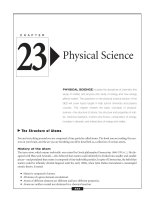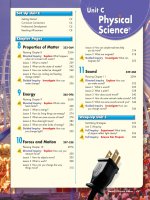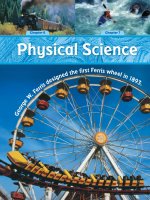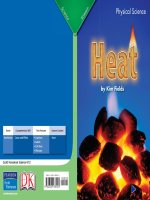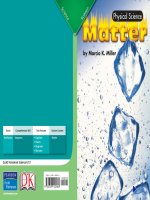physical science heat
Bạn đang xem bản rút gọn của tài liệu. Xem và tải ngay bản đầy đủ của tài liệu tại đây (7.22 MB, 10 trang )
by Kim Fields
Scott Foresman Science 4.12
Genre Comprehension Skill Text Features Science Content
Nonfi ction Cause and Effect • Captions
• Labels
• Call Outs
• Glossary
Heat
ISBN 0-328-13892-4
ì<(sk$m)=bdijca< +^-Ä-U-Ä-U
Physical Science
13892_CVR_FSD Cover113892_CVR_FSD Cover1 5/26/2005 10:24:52 AM5/26/2005 10:24:52 AM
by Kim Fields
Scott Foresman Science 4.12
Genre Comprehension Skill Text Features Science Content
Nonfi ction Cause and Effect • Captions
• Labels
• Call Outs
• Glossary
Heat
ISBN 0-328-13892-4
ì<(sk$m)=bdijca< +^-Ä-U-Ä-U
Physical Science
13892_CVR_FSD Cover113892_CVR_FSD Cover1 5/26/2005 10:24:52 AM5/26/2005 10:24:52 AM
Vocabulary
conduction
conductor
convection current
insulator
radiation
thermal energy
What did you learn?
1. What causes a metal spoon to get hot when one end
of it is placed in hot water?
2. Why are many hot foods served in foam containers?
3. How does energy from the Sun get to Earth?
4.
The meanings of heat and
temperature are often confused. On your own paper,
explain the difference between heat and temperature.
Use details from the book to support your answer.
5.
Cause and Effect What causes the movement
of air in a convection current?
Photographs: Every effort has been made to secure permission and provide appropriate credit for
photographic material. The publisher deeply regrets any omission and pledges to correct errors called to its
attention in subsequent editions. Unless otherwise acknowledged, all photographs are the property of Scott
Foresman, a division of Pearson Education. Photo locators denoted as follows: Top (T), Center (C), Bottom
(B), Left (L), Right (R) Background (Bkgd)
Opener: ©Charles O’Rear/Corbis; Title Page: ©A. Pasieka/Photo Researchers, Inc.; 2 ©William
Taufic/Corbis; 3 ©A. Pasieka/Photo Researchers, Inc.; 4 ©Paul Seheult/Eye Ubiquitous/Corbis; 5 Brand
X Pictures; 11 (BR) ©DK Images, (TR) Getty Images; 13 ©DK Images; 14 ©Chris Andrews Publications/
Corbis
ISBN: 0-328-13892-4
Copyright © Pearson Education, Inc.
All Rights Reserved. Printed in the United States of America. This publication is
protected by Copyright and permission should be obtained from the publisher prior
to any prohibited reproduction, storage in a retrieval system, or transmission in any
form by any means, electronic, mechanical, photocopying, recording, or likewise. For
information regarding permissions, write to: Permissions Department, Scott Foresman,
1900 East Lake Avenue, Glenview, Illinois 60025.
3 4 5 6 7 8 9 10 V010 13 12 11 10 09 08 07 06 05
13892_CVR_FSD Sec1:213892_CVR_FSD Sec1:2 5/26/2005 10:25:10 AM5/26/2005 10:25:10 AM
Heat
by Kim Fields
13892_01-16_FSD 113892_01-16_FSD 1 5/26/2005 10:27:03 AM5/26/2005 10:27:03 AM
2
Why does matter
have energy?
Energy in Matter
Energy is the ability to do work or cause a change. You use
energy to make heat when you rub your hands together. Cool
hands become warmer ones. All changes need energy. Energy is
used when there is a change to how something looks, what it is
made of, or where it is.
13892_01-16_FSD 213892_01-16_FSD 2 5/26/2005 10:27:08 AM5/26/2005 10:27:08 AM
3
Tiny moving particles make up all matter. Particles are
tightly packed in a solid. They only move slightly. In a liquid,
particles are close together. They flow freely. Particles are far
apart in a gas. They move all around. Particles move because
they have energy.
Thermal energy is energy due to moving particles that
make up matter. We feel the flow of thermal energy as heat.
An object’s particles move faster as it gets hotter. An object’s
particles move more slowly as it cools.
Colors in this heat picture show the different
amounts of heat energy.
13892_01-16_FSD 313892_01-16_FSD 3 5/26/2005 10:27:21 AM5/26/2005 10:27:21 AM
Measuring Moving Particles
Temperature is often measured with a thermometer. A
thermometer is usually a glass tube with a bulb that holds
colored alcohol. The degrees are shown by number lines on
the outside of the glass tube. The lines on one side of the tube
tell the degrees Fahrenheit. The lines on the other side tell the
degrees Celsius.
4
13892_01-16_FSD 413892_01-16_FSD 4 5/26/2005 10:27:26 AM5/26/2005 10:27:26 AM
Matter expands, or gets larger, when its particles move
faster. It contracts, or gets smaller, when particles slow down.
If a thermometer touches matter with fast-moving particles,
the particles in the colored alcohol speed up. They also move
farther apart. The liquid expands and moves up inside the tube.
The reading on the line shows a higher temperature. The liquid
in the tube contracts if the particles slow down. The reading on
the number line shows a lower temperature.
The thermometer has to be on or in what it’s measuring. If
the thermometer is not touching the substance, it might not
measure the motion of the particles correctly.
5
13892_01-16_FSD 513892_01-16_FSD 5 5/26/2005 10:27:35 AM5/26/2005 10:27:35 AM
Heat and Temperature
The particles of a material move fast when the material has
a high temperature. But temperature is not a measure of how
much heat a material has.
People often mix up the meanings of heat and temperature.
Temperature is the measure of the average amount of particle
motion in matter. It measures the
average energy. Thermal energy
measures the total energy of moving
particles. It measures how fast particles
move and how many are moving. Heat
is the movement of thermal energy from
one material to another.
6
13892_01-16_FSD 613892_01-16_FSD 6 5/26/2005 10:27:38 AM5/26/2005 10:27:38 AM
Suppose you filled a large pot and a small pot halfway with
boiling water. The large pot holds more water. It has many
more moving water particles. This means it has more energy of
motion. Because of this, the large pot has more thermal energy.
The temperature of the water in both pots is the same because
the water in each pot is boiling. The average amount of particle
motion is also the same. The size of the pot does not change
the temperature.
7
13892_01-16_FSD 713892_01-16_FSD 7 5/26/2005 10:27:44 AM5/26/2005 10:27:44 AM
How does heat move?
Conduction
Thermal energy flows from a warmer material to a cooler
one. The movement is what we feel as heat. A heat source
gives off energy that can be taken in by particles of matter.
Heat energy moves by conduction between two solids that are
touching.
Conduction happens when heat energy
is transferred by one thing touching another.
8
The metal spoon conducts heat well.
This causes the piece of wax on the
spoon to melt. The wooden spoon
does not conduct heat well. The piece
of wax on this spoon does not melt.
13892_01-16_FSD 813892_01-16_FSD 8 5/26/2005 10:27:47 AM5/26/2005 10:27:47 AM
Place one end of a cool metal spoon in boiling water. What
happens? The spoon gets hot! Particles in the spoon touch the
hot water. They start to move quickly. The particles crash into
other particles in the spoon’s handle. Soon heat energy moves
throughout the spoon. The transfer of energy continues until
the water and the spoon are the same temperature.
If you do the same thing with a wooden spoon, its handle
will stay cool. That is because the wooden spoon does not
conduct heat energy very well.
9
13892_01-16_FSD 913892_01-16_FSD 9 5/26/2005 10:27:51 AM5/26/2005 10:27:51 AM
10
Conductors and Insulators
A conductor is a material that allows heat to move through
it easily. Many metals, such as iron, aluminum, and copper, are
good conductors. An iron pan gets hot quickly when it is placed
on a heat source, such as a burner. A metal spoon is also a
good conductor.
Iron pan
13892_01-16_FSD 1013892_01-16_FSD 10 5/26/2005 10:27:54 AM5/26/2005 10:27:54 AM
11
Some things do not get warm even when they touch
something hot. An insulator is a material that doesn’t let
much heat pass through it. Wood is a very good insulator.
That is why many pots have wooden handles.
Marble is an insulator. It has been used in buildings since
ancient times. Plastic foam combines two good insulators:
plastic and air. Plastic foam containers keep your food warm
and your hands cool.
Plastic foam cup
Marble tray
13892_01-16_FSD 1113892_01-16_FSD 11 5/26/2005 10:27:57 AM5/26/2005 10:27:57 AM
12
Convection
A fluid is matter that does not have a definite shape. Water
and air are fluids. Heated fluids can move from place to place
in a process called convection.
A convection current is a pattern of flowing heat energy.
A convection current forms when a heated fluid expands.
Heat moves through air in a convection current. When air is
heated, it becomes less dense than the cooler air around it. The
cooler air sinks below the warmer air. This forces the warm air
upward. The cycle continues as more cool air is warmed and is
forced upward by colder air.
A radiator heats the
air by convection.
13892_01-16_FSD 1213892_01-16_FSD 12 5/26/2005 10:28:00 AM5/26/2005 10:28:00 AM
13
What is the heat source in this photo? It’s the candles. As
long as the candles are burning, movement of the rising warm
air will make the objects above the candles move. The energy
from the flames heats the air above them. The air particles
move faster and farther apart. This makes the air less dense.
Cooler air rushes under the less dense air. It pushes the warm
air upward.
Much larger convection currents change our weather.
Uneven heating of the air around Earth causes large currents.
They make Earth’s major wind patterns.
The heat from the
candles makes
the objects spin.
13892_01-16_FSD 1313892_01-16_FSD 13 5/26/2005 10:28:08 AM5/26/2005 10:28:08 AM
14
Radiation
Radiation is energy sent out in little bundles. You feel
radiation when you get warm in the Sun or sit by a fire.
Radiation can travel through empty space or through matter.
It is absorbed by dark, dull surfaces. Shiny surfaces reflect
radiation. Clear surfaces allow radiation inside. A greenhouse
is made of plastic or glass. Radiation from sunlight makes a
greenhouse warm even when it is cold outside.
Radiation is unlike conduction and convection. Conduction
happens when materials are touching each other. Convection
needs the heated particles of a fluid to carry energy. Radiation
does not need particles of solids, liquids, or gases. Radiation can
move energy great distances, even from the Sun to Earth.
13892_01-16_FSD 1413892_01-16_FSD 14 5/26/2005 10:28:14 AM5/26/2005 10:28:14 AM
Conduction, Convection, and Radiation
Energy from the Sun heats Earth’s surface through
radiation. The surface transfers heat to the air and warms
it through conduction. Convection currents also form as
Earth’s surface heats the air. These currents cause Earth’s
wind and rain patterns.
Energy is the ability to do work. Heat is the transfer of
thermal energy. It can be moved in several ways. Conduction,
convection, and radiation are all ways that heat is moved.
Think about how heat moves the next time you drink hot
cocoa, sit in a warm sunbeam, or take a hot bath.
15
13892_01-16_FSD 1513892_01-16_FSD 15 5/26/2005 10:28:20 AM5/26/2005 10:28:20 AM
16
Glossary
conduction the transfer of heat energy by one
thing touching another
conductor a material that allows heat to move
easily through it
convection current a pattern of flowing heat energy
insulator a material that limits the amount of
heat that passes through it
radiation energy sent out in little bundles
thermal energy energy due to moving particles that
make up matter
13892_01-16_FSD 1613892_01-16_FSD 16 5/26/2005 10:28:23 AM5/26/2005 10:28:23 AM
Vocabulary
conduction
conductor
convection current
insulator
radiation
thermal energy
What did you learn?
1. What causes a metal spoon to get hot when one end
of it is placed in hot water?
2. Why are many hot foods served in foam containers?
3. How does energy from the Sun get to Earth?
4.
The meanings of heat and
temperature are often confused. On your own paper,
explain the difference between heat and temperature.
Use details from the book to support your answer.
5.
Cause and Effect What causes the movement
of air in a convection current?
Photographs: Every effort has been made to secure permission and provide appropriate credit for
photographic material. The publisher deeply regrets any omission and pledges to correct errors called to its
attention in subsequent editions. Unless otherwise acknowledged, all photographs are the property of Scott
Foresman, a division of Pearson Education. Photo locators denoted as follows: Top (T), Center (C), Bottom
(B), Left (L), Right (R) Background (Bkgd)
Opener: ©Charles O’Rear/Corbis; Title Page: ©A. Pasieka/Photo Researchers, Inc.; 2 ©William
Taufic/Corbis; 3 ©A. Pasieka/Photo Researchers, Inc.; 4 ©Paul Seheult/Eye Ubiquitous/Corbis; 5 Brand
X Pictures; 11 (BR) ©DK Images, (TR) Getty Images; 13 ©DK Images; 14 ©Chris Andrews Publications/
Corbis
ISBN: 0-328-13892-4
Copyright © Pearson Education, Inc.
All Rights Reserved. Printed in the United States of America. This publication is
protected by Copyright and permission should be obtained from the publisher prior
to any prohibited reproduction, storage in a retrieval system, or transmission in any
form by any means, electronic, mechanical, photocopying, recording, or likewise. For
information regarding permissions, write to: Permissions Department, Scott Foresman,
1900 East Lake Avenue, Glenview, Illinois 60025.
3 4 5 6 7 8 9 10 V010 13 12 11 10 09 08 07 06 05
13892_CVR_FSD Sec1:213892_CVR_FSD Sec1:2 5/26/2005 10:25:10 AM5/26/2005 10:25:10 AM
